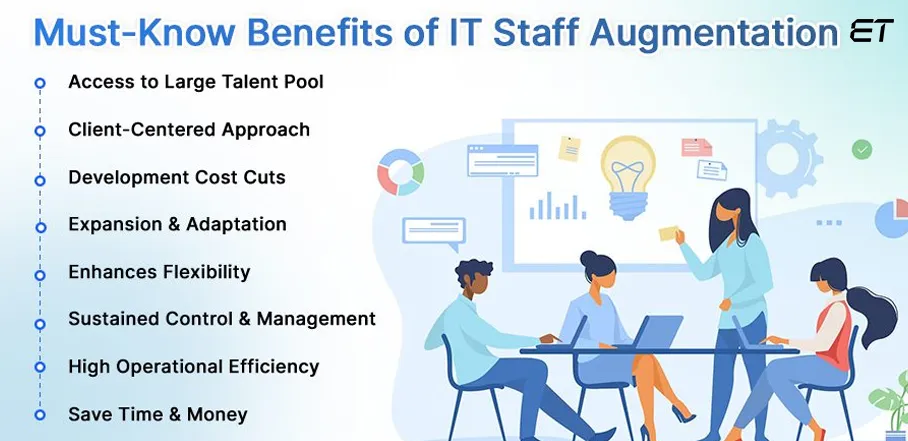Staff augmentation is on the rise, as modern-day businesses have an urgent need for flexible hiring solutions. Businesses, driven by market situations, must scale their teams quickly to address skill gaps and meet the project demands. In 2024, the staff augmentation services market was valued at USD 6.89 billion. By the end of 2025, the market valuation is expected to be worth USD 7.35 billion. According to predictions, this will grow to USD 10.34 billion by 2030.
The global shift towards remote work since the COVID outbreak, the accelerating speed of technological change, and the need to innovate are largely responsible for this growth. Talent is now available throughout the world. Businesses are looking for part-time skilled resources based on job requirements. Flexibility of the staff augmentation service lets businesses find the required talent, for the right period of time, and without the associated overhead expenses.
Understanding Staff Augmentation
Staff augmentation is a hiring model where businesses can get non-permanent, external professionals to supplement the existing workforce. Usually, the skilled resources are hired temporarily for seasonal upswings, for short-term projects, or to meet skill gaps. It helps companies find the right talent quickly and without any long-term commitment or cost.
Important Features of Staff Augmentation –
- Businesses have access to the right talent from anywhere in the world
- The right solution to find temporary talent
- It reduces the time to market by saving time and resources towards advertising, testing, and interviewing
- Businesses can scale up and scale down as needed
- Allows organizations to fill skill gaps
- Cost-effective solution for the short-term
- Organizations can adapt quickly to changing business and project needs
- Easy team integration
Key Benefits for Businesses
Here are some major benefits:
- Finding Specialized Skills – Your project may demand specialized skills that you don’t have in your current team. Staff augmentation will allow companies to find people with the skills needed from anywhere in the world. For instance, a tech business creating an AI-based web platform may need tech skills with knowledge of cloud computing and machine learning. Instead of spending time and resources on training, the company can opt for on-demand hiring to find people with the necessary skills easily.
- Efficiency, Speed – A typical hiring process usually takes weeks, and sometimes even months, which slows down the project timeline. Staff augmentation will speed this up as the required talent can be acquired quickly, ensuring that the project can proceed without any interruption.
- Find Talent On Trial – Potential team members can be hired on a trial basis to find out whether they can perform under pressure and integrate with the team and company culture before making a final decision. This approach gives the company time to make a decision.
- Better Focus on Core Activities – Giving more work to your in-house staff than they can manage is sure to lower efficiency and productivity. It will also push them towards burnout. Delegate to the outside team while your core team manages the most important jobs. They can then focus on mission-critical tasks.
- Cost-Effective – Businesses can reduce their fixed costs associated with full-time hiring, such as the cost of office space, benefits, and training. A lower cost will make the organization more profitable.
How Staff Augmentation Differs From Outsourcing and Full-Time Hiring
There are major differences between the three.
- Staff Augmentation – The outside staff works remotely or physically with the in-house workers and integrates seamlessly with the team. They use the existing tools and infrastructure. This arrangement is usually temporary. The management retains direct control. However, the HR activities and salaries are paid by the staff augmentation service provider.
- Full-Time Hiring – In this approach, the business hires professionals to work permanently with the team. It develops core organizational strengths, but the cost towards recruiting, salaries, training, infrastructure, and benefits is considerably higher.
- Outsourcing – Here, the entire or part of the project may be given to an outside vendor for development and management. The vendor will often use its own staff, resources, and infrastructure.
According to Newwavedevs СЕО Roman Oliinychenko, a leading IT staff augmentation company, common industries using staff augmentation include financial services, IT, e-commerce, logistics, and financial services. For example, tech firms that want to hire dedicated Ruby on Rails developers will often turn to staff augmentation to find professionals having the required skills and expertise.

The Challenges of Remote Work with a Staff Augmentation Company
Staff augmentation offers many benefits, which is why it has become so popular in the last few years. However, there can also be a few challenges, which include the following –
- Communication Barriers – Remote workers can feel disconnected and may struggle to align with the company culture. Those speaking another language may fail to understand instructions clearly. All this can cause errors and project delays.
- Management and Coordination Issues – Lack of direct supervision and performance tracking can become an issue if the remote team is located far away from the core team’s location. Project coordination and scheduling of meetings may become a challenge because of time zone differences.
- Security and Data Privacy Concerns – Managing sensitive data across borders can be a challenge. There can be digital vulnerabilities from using multiple devices in remote locations. Intellectual property theft is a real concern. The management can reduce the risk by using secure communication tools and through NDAs.
Opportunities Presented by Staff Augmentation in Remote Settings
Staff augmentation presents many opportunities for businesses
Access to Global Talent – It is now easier to find talent from anywhere in the world. If you go international, you will have many more options to choose from naturally. With staff augmentation, another organization will be in charge of finding the required skills, interviewing, and paying the salaries.
Cost Efficiency and Scalability – The organization providing staff augmentation will often look after payroll and HR-related activities for the augmented staff members. This reduces the internal administrative costs and the need to allocate resources.
Increased Productivity and Flexibility – It gives businesses the flexibility to scale up or scale down, depending on project demands and changing market conditions. Companies can find contract developers when needed, instead of going through a long recruitment process and without going into any long-term commitment. For example, a software development business can opt for a staff augmentation service and find additional developers during busy times and then ramp down later.
Best Practices for Successful Remote Collaboration
The use of project management and communication tools like Slack, Jira, Asana, and others can make management easier and further reduce the risks. When working with an outside team, make sure that it integrates well with the in-house staff and understands the organization’s vision, values, and culture. Establish clear KPIs, roles, and responsibilities. Carry out performance reviews regularly and offer honest feedback.
Invest in knowledge-sharing systems to integrate both teams and ensure that the professionals working from the outside don’t feel alienated. They should have access to all the information and resources.
Remote work and staff augmentation are both here to stay. They offer businesses many advantages. The challenges can be overcome with foresight, experience, and careful planning.






0 Comments